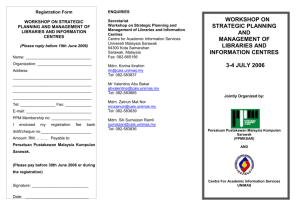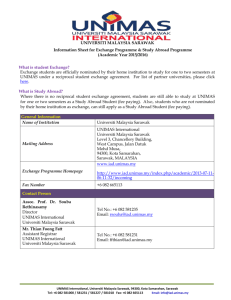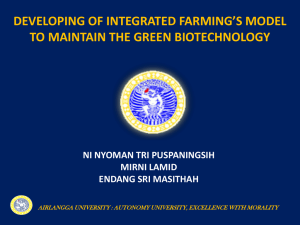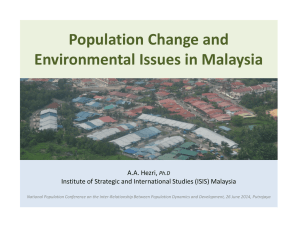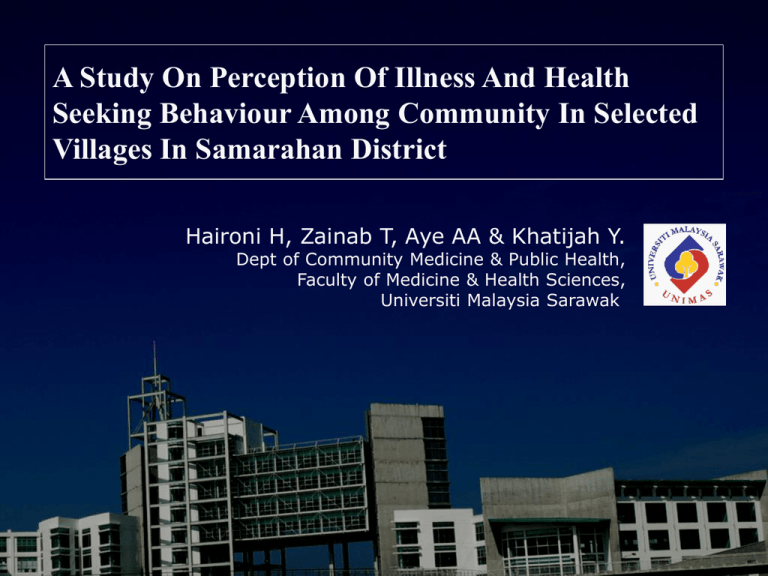
A Study On Perception Of Illness And Health
Seeking Behaviour Among Community In Selected
Villages In Samarahan District
Haironi H, Zainab T, Aye AA & Khatijah Y.
Dept of Community Medicine & Public Health,
Faculty of Medicine & Health Sciences,
Universiti Malaysia Sarawak
Introduction
• Illness perception is based on beliefs or
cognitive representations that a patient
has about their illness.
• Its components include
•
•
•
•
the name of the illness
range of symptoms associated with it
beliefs on cause of the illness
how long it will last, personal consequences if
any
• and the extent in which the illness is amenable
to personal control or require treatment.
Universiti Malaysia Sarawak (UNIMAS)
Literature Review
• Illness perception
– Important determinants of behaviour and
associated with important outcomes in
treatment adherence and functional
recovery (Petrie, Jago & Devcich, 2007)
– Strong associations exist between illness
perception and use of healthcare (Giri et al,
2009)
Universiti Malaysia Sarawak (UNIMAS)
Literature Review (2)
• Health seeking behaviour
– Utilization of a health care system is
dependent on various factors, either
physical, socio-economic, cultural or
political influence (Shaikh & Hatcher, 2004)
– Various models have been used to explain
behavioural changes in utilization of health
care including the Health Belief Model and
Theory of Planned Behaviour
Universiti Malaysia Sarawak (UNIMAS)
Literature Review (3)
• Health seeking behaviour
– Influenced by socio-economic variables,
age, sex, social status of women, type of
illness, access to services and perceived
quality of service (MacKian, 2003)
Universiti Malaysia Sarawak (UNIMAS)
Objectives
• To determine the pattern of health
seeking behaviour and perception of
illness in 4 selected villages in
Samarahan
Universiti Malaysia Sarawak (UNIMAS)
Methodology
• Cross sectional study
• 4 selected villages in Samarahan
– Kampung
– Kampung
– Kampung
– Kampung
Tanjong Bundong
Baru
Niup
Tanjong Parang
• Simple Random sampling
Universiti Malaysia Sarawak (UNIMAS)
Area of Study
Samarahan District
• Population 246,782
(2010)
• Race – Malays, Bidayuh,
Iban and Chinese
• Main activity –
agriculture
• 4 villages situated 1020 km from the nearest
clinic
Universiti Malaysia Sarawak (UNIMAS)
Questionnaire
• Interviewed, 2 parts of questionnaire
• Part I (Perception on illness)
– Diet, physical activity, immunization,
antenatal follow-up, pap smear, breast selfexamination, sexual promiscuity, alcohol
and substance abuse, cigarette smoking
and general perception on health
• Part II (factors on health seeking behaviour)
– Traditional medicine practices, vitamin and
supplement intake, treatment preferences
and beliefs on illness
Universiti Malaysia Sarawak (UNIMAS)
Distribution of respondents by village
Universiti Malaysia Sarawak (UNIMAS)
Distribution of respondents by gender
Universiti Malaysia Sarawak (UNIMAS)
Choice of seeking treatment preferred
Universiti Malaysia Sarawak (UNIMAS)
Types of traditional medicine used
Universiti Malaysia Sarawak (UNIMAS)
Intake of vitamins & supplements
Universiti Malaysia Sarawak (UNIMAS)
Belief on cause of illness
Universiti Malaysia Sarawak (UNIMAS)
Perception score
Universiti Malaysia Sarawak (UNIMAS)
Perception score by village
Poor Perception
Good Perception
Kpg Tanjung Bundong
12
27
Kpg Baru
13
26
Kpg Niup
14
27
Kpg Tanjung Parang
14
24
53
104
(χ2 = 0.323, df = 3, p = 0.956)
Universiti Malaysia Sarawak (UNIMAS)
Perception and vitamin intake
Good Perception
Poor Perception
Vitamin intake - yes
72
35
Vitamin intake - no
32
30
(χ2 = 9.806, df = 1, p = 0.02)
Universiti Malaysia Sarawak (UNIMAS)
Gender and Beliefs on cause of illness
Males
Females
Beliefs - yes
62
27
Beliefs - no
34
34
(χ2 = 6.276, df = 1, p = 0.012)
Universiti Malaysia Sarawak (UNIMAS)
Discussion
• Despite living in rural areas, government
health clinics is still the preferred centre
for seeking treatment among this
community.
• However a large proportion of the
community surveyed still use traditional
medicine, vitamin intake and believed
that illness is due to causes other than
micro-organisms.
Universiti Malaysia Sarawak (UNIMAS)
Discussion
• Those taking vitamin and supplements
were noted to have better perception on
health.
– Daily multivitamin intake, especially among
the elderly has been shown to reduce
number of illness days due to infection by
50% (Jasti et al, 2003)
Universiti Malaysia Sarawak (UNIMAS)
Discussion
• Males were noted to be more likely to
believe that illness is due to causes
other than micro-organisms
– Studies on gender difference have shown that
more women visited traditional healers before
diagnosis and men tended to visit government
medical establishments first (Yamasaki-Nakagawa
et al, 2001)
– Prevailing system of values preserves the
segregation of sexes and confinement of women to
her home (Shaikh & Hatcher, 2005)
Universiti Malaysia Sarawak (UNIMAS)
Conclusion
• Majority of respondents in this community still
preferred to seek treatment from government health
centres, despite its distance.
• Despite utilization of the health care system, a large
proportion of the surveyed community practice
traditional medicine and vitamin supplements.
• Most of the respondents surveyed have good
perception to health, particularly those taking vitamin
supplements
• Patient’s perception to illness can influence their
coping ability, compliance to treatment and functional
recovery.
Universiti Malaysia Sarawak (UNIMAS)
Thank You

